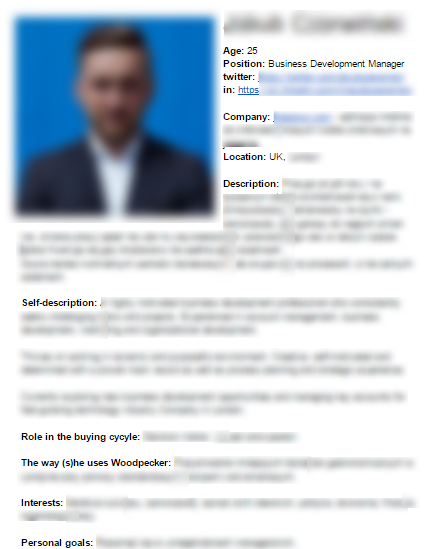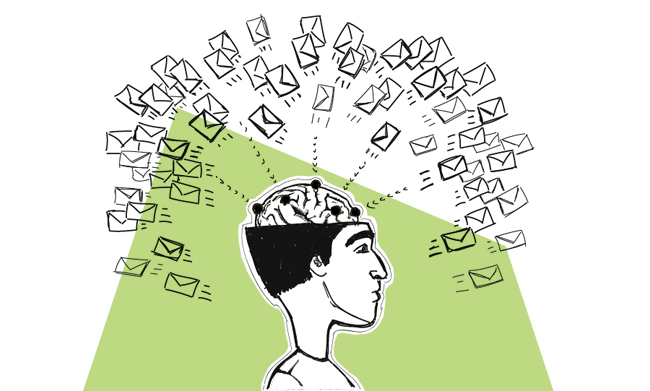Do you know who your prospects are as people? What do they like? What do they care about? What are the things that they can’t stand? What are their personal and business goals? Here’s how we’ve found specific answers to all those questions for our business, and why finding those answers is so important for the success of your company.
Before you start looking for the answers…
In my previous post, I wrote about the first step to building a good prospect base. That’s the first step we took, and it helped us an awful lot.
So check out this one if you don’t have an ideal customer profile (ICP) figured out yet. In the B2B domain that we focus on, you need to know:
- what kind of companies you’re aiming at,
- what role the person you want to talk to plays in the company,
- why this kind of a company and why the person on this position.
As soon as you have figured that out, you can go further and try to find out who the person really is.
So, is it about persona development?
Well, kind of. You want to define some personal characteristics of your ideal client, as well as their painpoints, goals and needs. In our case, the demographic part was already taken care of when deciding on the niche we were going to focus on.
But how do you actually get about developing the marketing personas?
You sit down, and you brainstorm. You come up with a “Sad Samuel” or a “Knowing Nancy” and you create the persona profile answering all the crucial questions on their behalf. But is it the only way to create your personas?
Here’s how we did it
We could go the sit-and-brainstorm way as well. But instead, we decided to do a kind of “back engineering”, that is: to screen the very people who already became our first customers.
We construted a template of a customer-file (I call it a C-file). The template included:
- Our customer’s pic
- Their age
- Their position in the company
- Name of the company and a short description of what they do
- Location of the company
- Our short description of the person (on the basis of their conversations with our Sales Reps – Wojtek & Vovik)
- The person’s self-description – if we could find it in social media (LinkedIn rules in this regard)
- Role in the buying cycle: economic buyer/technical buyer/end user
- The way (s)he uses Woodpecker – goal and workflow
- Interests (based on social media profiles)
- Personal goals

So in the end, it looked like a classic persona profile. The crucial difference was, however, that instead of a made-up “Sad Samuel,” we created a profile of an actual person, who has already trusted Woodpecker as a company and is currently drawing value from the solution we offer.
Our “back engineering” vs. traditional persona development
What are the advantages of the “back engineering” approach over the traditional persona development?
- We didn’t have to make things up. We just did some research in social media and we interviewed our sales guys to gather some first-hand information.
- Our customer profiles include our clients’ real interests and goals. It’s not what “we think” our customers want and aim at. It’s what they actually wrote or said.
- We gathered some real samples of our customer’s language. Preparing the profiles, we gained some insight into the way our actual customers talk and write about their painpoints and needs. All that will help us craft the messaging for our prospective clients in the future.
- The C-files showed us some recurring patterns. We did our first step by defining our ideal customer profile. And in this second step of persona development, our assumptions from step one found some serious support. That was really reassuring – we found some proof that we’re heading at the right direction in our marketing and sales efforts.
What’s in it for you?
Now, depending on the stage you’re on now, you may have various feelings about our approach to persona development. Check out the four scenarios below, and fit your current situation into one of them.
Scenario 1: You haven’t defined your niche and your Ideal Customer Profile, yet. You thought persona development is actually step one.
What to do?
First things first, you need to define your ICP. Persona development is step two. Go to my previous post, read it and check out the two resources I mention there.
What’s the First Step to Building a Good Prospect Base? >>
As you define your ICP, go back here for scenario 2 or 3.
Scenario 2: You have defined your niche and your Ideal Customer Profile. You have some first customers, so you can prepare your own C-files as to use them as your persona profiles, like we did.
What to do?
Open a new document, create a template and get ready to start taking notes.
Set a meeting with your sales reps, support guys, customer happines officers, or whoever else talks with the clients. Ask them the questions from your template. Build the profiles together. Dig into your clients’ social media profiles to find some live language and supplementary first-hand info.
Create several C-files and look for recurring patterns. Do your clients fit into your ICP?
Scenario 3: You have defined your niche and your Ideal Customer Profile, but you don’t have any customers yet. You want to create personas to know what clients you’re supposed to focus on.
What to do?
Open a new document, create a template and get ready to start taking notes.
Go to social media, forums and places where your ideal customers gather to talk. Find some people you would love to have as your first customers. Dig into their profiles, and fill in your C-file template on the basis of your findings.
Next, try to find those people’s email addresses and reach out to them to start some relations with your first potential clients. Try using a personalized email with follow-up. Don’t focus on selling your solution, though. Focus on learning about them as people involved in business.
Check the post below for some guidance:
How We Got Our First 10 Customer Interviews with Cold Email >>
Scenario 4: Something completely different.
If you don’t fit into any of these scenarios, I’m more than curious to read your story. You can share it below in the comments section, or drop me an email.
***
Hope this helps! Let me know what you think of our approach to persona development, and why you think so.
READ ALSO

Cold Email Statistics Based on Sending Over 20M Cold Emails
Over the span of 2 years, Woodpecker has grown a lot faster than we’ve predicted. We have 1000+ customers on board who come from 52 different countries. But what’s more important for today’s blog post, Woodpecker has sent way more than 20 million sales emails throughout all this time.

6 Resources to Help You Build Contact Base for Cold Emailing
Obviously, any cold email campaign cannot exist without prospects. So as soon as we're ready to get about crafting our cold emails, we also need to find our prospects' adressees. In step one, we define the profile of our ideal prospect. But in step two, it's time to look for some actual contact data. First and foremost, we need our prospect's email address, name and company. Then, we can find some more information to personalize our emails. In this post, I give you 6 resources that we found helpful when building our prospecting process. Hope you will find them helpful as well.

SaaS customer interviews: How to carry them out & what you can learn
When was the last time you actually talked to your customers? I don't mean a sales call or a demo. I mean actually talking about their business, your business, and how the two virtually affect each other. Our Outbound Sales team has just finalized their 3.5-month long project of customer interviews. Last week, they presented the results to the whole Woodpecker team. That inspired me to write about how you can do it as well at your SaaS company. So here it goes! See how to carry out customer interviews and what you can learn from talking to your clients.
